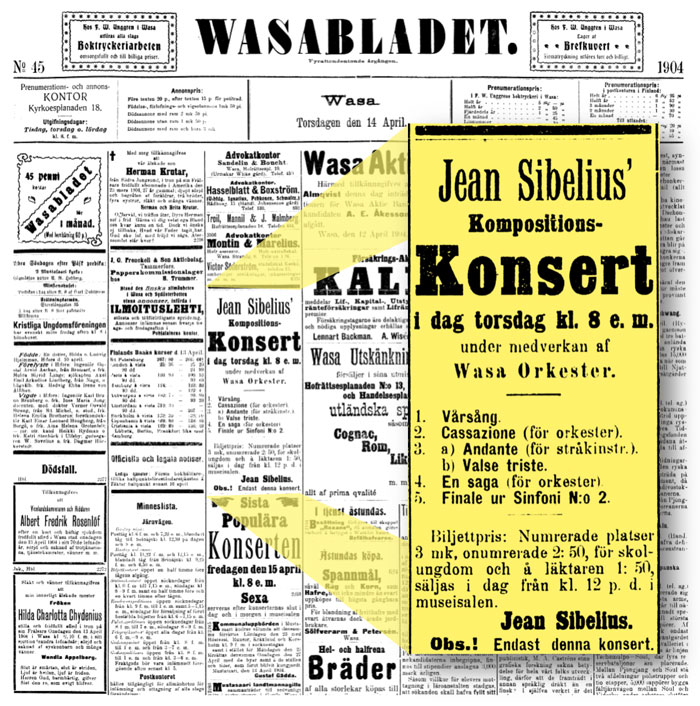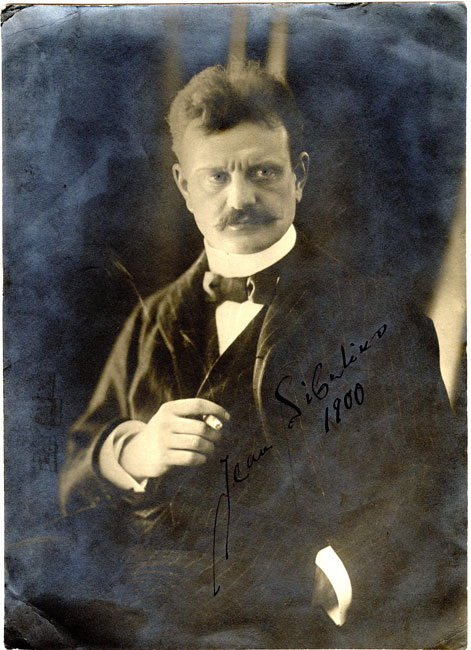Jean Sibelius’s famous Valse triste was performed on 14 April 1904 in Vaasa, ten days before its purported premiere in Helsinki
Sheahan Virgin
Jean Sibelius’s Valse triste is one of his most popular compositions. It began life as ‘Tempo di valse lente – Poco risoluto’, its original purpose having been to accompany a dance scene in Death (Kuolema), a three-act, Symbolist play by Sibelius’s brother-in-law Arvid Järnefelt (1861–1932).[1] The play was premiered on 2 December 1903 at the Finnish Theatre in Helsinki, with Sibelius conducting.[2] Shortly thereafter, he refashioned the waltz into a standalone concert piece, to which he gave the now-familiar name Valse triste. Most notably, he altered the ending and added parts for flute, clarinet, horn and timpani.[3]
On 25 April 1904, the Helsinki Philharmonic Society held a charity concert to raise money for its pension fund. Sibelius was on hand at the University of Helsinki’s Solemnity Hall to conduct the Romance in C major (1904; then called ‘Andante’ for strings)[4] and his ‘new’ Valse triste, the latter of which was encored.[5] The city’s music critics reviewed the piece favourably. Writing in Hufvudstadsbladet, Alarik Uggla (1860–1908) described Valse triste as ‘a delightful composition… melodically appealing and evocative of a fleeting dream-vision’,[6] while Karl Flodin (1858–1925) in Helsingfors-Posten found Valse triste to be ‘the kind of piece that burns itself into your consciousness… a strange mixture of pale-blue fantasy and swaying waltz rhythm’.[7] Finally, Evert Katila (1872–1945) of Uusi Suometar characterized Valse triste as ‘an incomparable piece of mood painting… musically, a masterful treat’; however, he conceded the waltz ‘had carried [him] even more completely’ in its original form as a piece accompanying Järnefelt’s play.[8]
Subsequent scholarship has afforded this concert additional significance by listing it as the world premiere of Valse triste.[9] However, newly-reviewed primary sources demonstrate this date was not, in fact, the waltz’s first public performance. According to Vasabladet, a Swedish-language newspaper that served the region of Ostrobothnia, Sibelius conducted Valse triste on Thursday 14 April at the town hall in Vaasa, a coastal city 420 kilometres to the northwest of Helsinki.[10] The Vaasa Orchestra – a small ensemble that required reinforcements for the event – played a programme that included Sibelius’s En saga (1892, revised 1902), Spring Song (1894; revised 1895), movement IV of the Symphony No. 2 (1902),[11] the original version of Cassazione (1904, revised 1905) and the Romance.
These details come to us via two articles in Vasabladet: first, a 14 April advertisement announcing Sibelius’s concert that evening; and second, a 16 April review by a critic under the pen name ‘T.S.’[12] The Thursday concert ‘filled the town hall to the brim’, and upon appearing on stage Sibelius received from the audience ‘hearty, vigorous applause… [he was] the hero of the day even before the first chords [were played].’ T.S. praised Valse triste specifically as ‘infinitely subtle, melodic, and beautiful in the best sense of the word’ and characterized Sibelius’s conducting as ‘captivating… [it is] astonishing… that an orchestra as small as the city’s own produced all this wonderful music.’ Importantly, T.S. noted that, while the Romance, Valse triste and Cassazione were ‘completely new compositions… originating… from this year’, only ‘the first two’ had ‘not yet been played in Helsinki’ (emphasis added).[13] Sibelius conducted Valse triste again the next day at a similarly well-attended concert; he repeated Thursday’s programme, albeit with the addition of Finlandia (1899, revised 1900).
Fidelity to the historical record warrants a disclaimer: while the Vasabladet articles are the earliest records in the National Library of Finland’s digital archives,[14] the newspaper does not use the word ‘premiere’ to described the performance of Valse triste. It is possible, then, that the waltz was played elsewhere before 14 April. This, however, is unlikely: given Sibelius’s domestic – and increasingly international – celebrity at the time, there is no reason to believe a prior concert went unreported by the Finnish press.
References
Primary sources (by date)
Jean Sibelius’ kompositions-konsert [Jean Sibelius’s composition concert]. (14 April 1904). Vasabladet, 45, 1. https://digi.kansalliskirjasto.fi/sanomalehti/binding/1050602?page=1.
T.S. (16 April 1904). Jean Sibelius’ konserter [Jean Sibelius’s concerts]. Vasabladet, 46, 2. https://digi.kansalliskirjasto.fi/sanomalehti/binding/1050603?page=2.
Filharmoniska Sällskapet [Philharmonic Society]. (April 24 1904). Hufvudstadsbladet, 110, 3. https://digi.kansalliskirjasto.fi/sanomalehti/binding/754049?page=3.
Flodin, Karl [K.]. (26 April 1904). Populära konserten i afton [Popular concert yesterday evening]. Helsingfors-Posten, 112, 2. https://digi.kansalliskirjasto.fi/sanomalehti/binding/628451?page=2.
Merikanto, Oskar [O.]. (26 April 1904). Filharmoonisen seuran konsertti [The Philharmonic Society’s concert]. Päivälehti, 72, 3. https://digi.kansalliskirjasto.fi/sanomalehti/binding/680036?page=3.
Uggla, Alarik [A.U.]. (26 April 1904). Konserten för orkesterns pensionskassa [The concert for the orchestra’s pension fund]. Hufvudstadsbladet, 112, 6. https://digi.kansalliskirjasto.fi/sanomalehti/binding/754052?page=6.
Katila, Evert [E.K.]. (27 April 1904). Konsertti orkesterin eläkerahaston hyväksi [Concert for the benefit of the orchestra’s pension fund]. Uusi Suometar, 96, 4. https://digi.kansalliskirjasto.fi/sanomalehti/binding/798923?page=4.
Merikanto, Oskar [O.]. (1 May 1904). Helppotajuisessa konsertissa [Popular concert]. Päivälehti, 77, 4. https://digi.kansalliskirjasto.fi/sanomalehti/binding/680043?page=4.
Secondary sources
Barnett, Andrew (2007). Sibelius. New Haven, Connecticut: Yale University Press.
Dahlström, Fabian (2003). Jean Sibelius: Thematisch-bibliographisches Verzeichnis seiner Werke [Jean Sibelius: A Thematic Bibliographic Index of His Works] (in German). Wiesbaden: Breitkopf & Härtel.
Grimley, Daniel (2021). Jean Sibelius: Life, Music, Silence. Cornwall: Reaktion Books.
Kurki, Eija (1997). Jean Sibelius: Karelia – Complete score / Kuolema – Incidental music, including original version of Valse triste (CD booklet). Translated by Andrew Barnett. BIS Records. p. 9–11. BIS-915.
Tawaststjerna, Erik (2008a [1965, 1967]; translated 1976). Sibelius: Volume I, 1865–1904. Translated by Robert Layton. London: Faber and Faber.
Tawaststjerna, Erik (2008b [1972]; translated 1986). Sibelius: Volume II, 1904–1914. Translated by Robert Layton. London: Faber and Faber.
Virtanen, Timo, ed. (2019). ‘Introduction’. Finlandia, Op. 26 / Valse triste, Op. 44 No. 1 / Scen med tranorna, Op. 44 No. 2 / Canzonetta, Op. 62a / Valse romantique, Op. 62b / Valse lyrique, Op. 96a / Valse chevaleresque, Op. 96c. Urtext from the Complete Edition of Jean Sibelius Works, Series I – Orchestral Works, Volume 22. National Library of Finland and the Sibelius Society of Finland. Wiesbaden: Breitkopf & Härtel. p. viii–xv. SON 630.
[1] See Kurki (1997, pp. 9–10) for the most detailed synopsis of Järnefelt’s play.
[2] Dahlström (2003, pp. 198–200), Barnett (2007, pp. 157–159), Tawaststjerna (2008a, pp. 287–289), Grimley (2021, pp. 90–92).
[3] In the play, the music abruptly ends when Death knocks three times at the door, having arrived to claim the soul of the main character’s mother. Gravely ill, she has dreamed the dance scene while on her deathbed. The ending of the revised waltz, however, features a delicate passage of three chords played by four violins (Kurki, 1997, p. 10). As Barnett (2007, p. 163) notes, this is a ‘much more effective conclusion’ and makes for a more satisfying concert piece.
[4] The Romance in C major was premiered in Turku on 26 March 1904 (Dahlström, 2003, p. 195; Barnett, 2007, p. 163).
[5] At the 25 April concert, the orchestra’s founder and principal conductor Robert Kajanus (1856–1933) also conducted Tchaikovsky’s Symphony No. 6 (1893), Mendelssohn’s Violin Concerto (1844), and Richard Strauss’s tone poem Till Eulenspiegel’s Merry Pranks (1895) (Flodin, 1904, No. 112, p. 2; Katila, 1904, No. 96, p. 4). In addition, on 30 April, Kajanus conducted Valse triste at the final popular concert of the season. According to Oskar Merikanto’s (1868–1924) review in Päivälehti (1904, No. 77, p. 4), the ‘strangely charming’ piece delighted the at-capacity audience.
[6] Uggla (1904, No. 112, p. 6).
[7] Flodin (1904, No. 112, p. 2); also quoted in Virtanen (2019, p. x).
[8] Katila (1904, No. 96, p. 4).
[9] See, e.g., Dahlström (2003, p. 201), Barnett (2007, p. 163), Virtanen (2019, pp. viii–xv); cf. Tawaststjerna (2008b [1972]), who establishes a connection between Valse triste and Vaasa: ‘Then in April’, he writes, ‘came a couple of concert appearances in Vaasa in aid of the Helsinki orchestra’s pension fund at which Sibelius conducted his new “Andante” and, for the first time in a concert hall, Valse triste’ (p. 19). It is worth noting, however, that Tawaststjerna does not pinpoint the date as 14 April 1904. Moreover, Vasabladet does not link the Vaasa concerts to a benefit on behalf of the Helsinki Philharmonic Society, which indeed was the purpose of the 25 April concert ten days later in the capital (Uggla, 1904, No. 112, p. 6; Katila, 1904, No. 96, p. 4).
[10] Sibelius was quite familiar with Vaasa, as during his courtship of Aino Järnefelt (1871–1969) in the early 1890s, he had often visited the family estate at Tottesund, near Vaasa. Indeed, it was during a small ceremony at the estate that Jean and Aino married on 10 June 1892 (Tawaststjerna, 2008a [1965, 1967], pp. 69, 121; Barnett, 2007, p. 75). Two years later on 21 June 1894, Sibelius premiered the original version of Spring Song at a choral festival in Vaasa (Dahlström, 2003, p. 56; Barnett, 2007, pp. 93–94; Tawaststjerna, 2008a [1965, 1967], pp. 151–152; T.S., 1904, No. 46, p. 2).
[11] Given that movement IV is played attacca (Barnett, 2007, p. 147), Sibelius included the final bars of movement III as a bridge into the finale (T.S., 1904, No. 46, p. 2).
[12] Unfortunately, I have been unable to find additional information about the identity of this individual.
[13] T. S. (1904, No. 46, p. 2). On 8 February 1904, Sibelius conducted the original version of Cassazione in Helsinki, a concert better known for the premiere of the original version of the Violin Concerto in D minor (Dahlström, 2003, pp. 19, 220–221; Barnett, 2007, pp. 160–162).
[14] Using the search term ‘Valse triste’ and setting the date filter as 01.01.1904 to 30.04.1904.
Photo credits
- ‘Advertisement of Sibelius’s concert.’ Vasabladet, 45, 1. (14 April 1904). Photo illustration by the author.
- ‘Postcard from 1902 of Vaasa’s Holy Trinity Church and Town Hall.’ Finnish Heritage Agency.https://www.finna.fi/Record/museovirasto.C2DBB8BF0DCC3B331CBA5AFDDE6D650D.
- ‘Photo of Sibelius circa 1900.’ Sibelius Museum.https://www.finna.fi/Record/sibelius.35F0F57B0A494426B695B501E1EB562B?sid=3606072554.
About the author
The author thanks Andrew Barnett, Eija Kurki, Henry Rietz and Timo Virtanen for their helpful comments on earlier versions of this article.
Sheahan Virgin, Ph.D., is an assistant professor of political science in the United States. He first discovered Sibelius in 2013 after digging up a bargain bin treasure: BIS’s world premiere recording (BIS-815) of the tone poem The Wood-Nymph. (His subsequent discovery of the choral symphony Kullervo and of the tone poems En saga and The Oceanides certainly sealed the deal.) Thus began a decade-long passion for the composer and his music, as well as the history and culture of Finland. Sheahan also likes to spend time with his dog, Adlai, the middle name of whom is… gulp… Sibelius. (Unconscionably, the family vetoed it as the dog’s first name.)


